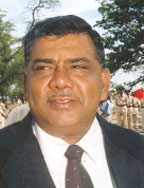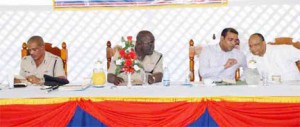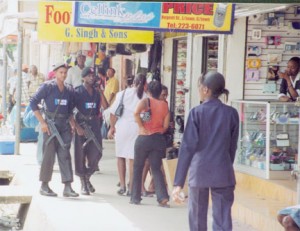President Bharrat Jagdeo came to power nearly 10 years ago. What public safety lessons can be learnt from the extraordinary events that occurred during the most dangerous decade in this country’s history?
When Mr Bharrat Jagdeo was elevated to the presidency nearly 10 years ago on August 11, 1999, there were hopes that the country’s dangerous security situation would improve. There was a common belief, too, that Guyana’s seventh President, who had not yet been born at the time of ‘The Disturbances’ of the 1960s, would quell the unrest which had threatened to paralyse public administration.

Mr Jagdeo’s conciliatory inaugural presidential address promised to restore a high level of human security and set the country back on the path of economic recovery. The opposite occurred. Instead of getting better, the situation rapidly deteriorated with the outbreak of serious troubles on the East Coast Demerara. The lessons of those troubles which defined public safety during the last decade are legion. They are, however, not entirely the product of President Jagdeo’s ten-year tenure of office although it is quite clear that those have been the worst years for security.
The troubles were the result of five factors – first, the extreme polarisation which existed during the preceding presidency of Mrs Janet Jagan in the wake of the 1997 general elections; second the tolerant attitude towards the employment of extra-judicial executions as a means of eliminating persons suspected of being criminals; third, the incapacity of the law enforcement agencies and the criminal justice system; fourth, political interference in the professional management of the police force; and, fifth, the reluctance to implement reasonable, remedial measures in a timely manner.
The most serious breaches of public order and public safety over the past decade include the storming of the presidential complex in July 2002; the assassinations of a government Minister and the deputy head of the Customs Anti-Narcotics Unit and attempted assassination of the Director of Public Prosecution; the theft of weapons from the Defence Force; the increase in extra-judicial killings by the police; the indiscriminate slaughter of policemen in retaliation; and several massacres of innocent persons. Five important lessons can be learnt from this troubled period.
First, the political lesson could have been learnt in the early stages of the crisis. President Bharrat Jagdeo and then Opposition leader Desmond Hoyte met in April 2002, only two months after the escape of a gang of five desperate criminals from the Georgetown Prison on Mashramani day, and issued a joint statement condemning the incipient violence. They agreed to establish several joint committees to make proposals for the improvement of living conditions in ‘depressed communities’ among which Buxton-Friendship was listed.
The idea was that not just crime, but also the causes of crime, should be eradicated and potential breeding grounds of criminality should be eliminated. But this bi-partisan political process was not allowed to function as intended; the proposals were abandoned and, unsurprisingly, the problems persisted. Simple logic should have suggested that every legal lever ought to have been used to build a broad social and political consensus to win the hearts and minds of villagers and to isolate the criminals from law-abiding citizens.

Second, the policing lesson concerns the escalation in the number of extra-judicial killings by rogue elements in the Guyana Police Force. This practice was facilitated by the formation of various quick-reaction squads, the most lethal of which was called the Target Special Squad which came under the command of Superintendents Leon Fraser and Stephen Merai during the period of the troubles. Extra-judicial killings made an immediate and negative impact on families and society. The United Nations Human Rights Committee made recommendations to the Government of Guyana for the prompt investigation of police killings and excessive use of force and for measures to ensure the prosecution of offenders and the provision of effective remedies to victims. The recommendations were largely ignored and public investigations were often not conducted into such killings.
Public attention was riveted by a live television show on February 9, 2000 as cameras recorded a police officer shooting and killing the wanted man Linden “Blackie” London as he appeared to surrender. But, perhaps, it was the killing of Tshaka Blair in Buxton on April 6, 2002 by the police that could be regarded as the single event which tipped that village into a spiral of violence. The evidence suggests that the excesses of the Target Special Squad and the seemingly endless series of extra-judicial killings, unwarranted arrests, searches and harassment, triggered a cycle of unprecedented retaliatory killing of policemen by criminals. Belatedly, the special squad was disbanded and the cycle was broken.
It was also evident that much of the trouble was caused by an undeclared ‘dirty war’ between, on the one hand, armed gangs operating mainly out of the Buxton-Friendship community, who were ruthlessly killing, kidnapping and robbing and, on the other hand, the police, who were actively engaged in killing over several dozen so-called? It was also clear that several other murderous ‘phantom’ militias were prowling the countryside and city, armed to the teeth with modern high-powered weapons and supported by hi-tech computing and communication equipment and doing some killing on their own account.

Third, the planning lesson ought to have been an important legacy of the troubles. As early as June 2002, the president promulgated a counter-crime plan. This original 9-point plan, however, seemed concerned with enforcement issues — guns, gear, vehicles etc — for the police and did not attempt to address the social, economic and political issues which lay beneath the still simmering unrest and which had formed the basis of the accord with Opposition leader Desmond Hoyte only two months earlier.
During the crisis, the administration also received the reports of its own Steering Committee of the National Consultation on Crime, the Border and National Security Committee and the Disciplined Forces Commission. Ironically, one of the finest was the UK DfID-funded, Symonds Group’s Guyana Police Reform Programme Strategic Report of 2000 which, if earnestly implemented, would have better prepared the police force for the surge in violence after 2002.
In addition, the annual US Department of State’s International Narcotics Control Strategy Report and Country Reports on Human Rights Practices provided timely and useful indicators of security interest. Unfortunately, the numerous recommendations of these reports, and even the National Drug Strategy Master Plan, 2005-2009 that was launched in June 2005 were never incorporated into a coherent national security strategy and have never been comprehensively implemented.
Fourth, the legal lesson, perhaps, has been the most monumental legacy of the troubles. From the surge in serious criminal violence in 2002, the National Assembly passed a large number of security-related bills which included the Prevention of Crimes (Amendment) Bill, dealing with the monitoring of deportees; the Criminal Law Offences (Amendment) Bill, determining the mandatory sentence for “a terrorist act”; the Racial Hostility (Amendment) Bill; the Firearm (Amendment) Bill which allows for increases in penalties for persons found in possession of unlicensed firearms; the Summary Jurisdiction (Offences) (Amendment) Bill prescribing penalties for those who harbour criminals; the Evidence (Amendment) Bill; the Criminal Law Procedure (Amendment) Bill; and the Criminal Procedure (Plea Bargaining and Plea Agreement) Bill and several others.
Detection of crimes, prosecution of offenders and the overall enforcement of these new laws, however, has remained a problem. Largely because of the incapacity of the criminal justice system, there have been few prosecutions.
Fifth, the governance lesson is still to be learnt at various levels. It was only in the wake of two atrocities at Lusignan and Bartica in 2008 when the troubles were in remission that the administration resumed serious efforts to rebuild social and political consensus on public security issues. This year, 2009, the National Assembly passed a constitution amendment bill to establish the Oversight Committee on the Security Sector.
For the Police Force itself, the Police Complaints Authority and the Office of Professional Responsibility have proven to be dull weapons with which to wage war against professional wrongdoing. It should be obvious that the police complaints system has to be overturned completely to ensure that complaints against the police are investigated by an impartial tribunal that is completely separate from the police force. In addition, coroners’ inquests must be held into unnatural deaths – most particularly those involving the police force. Some of these, which have been halted by the intervention of the Director of Public Prosecution, should be resumed.
One promising move was President Bharrat Jagdeo’s establishment in May 2004 of a commission of inquiry to investigate the alleged involvement of the Minister of Home Affairs in directing a death squad. Unfortunately, the prime witness in the matter was executed before his evidence could be heard and no other witnesses could be persuaded to come forward voluntarily thereafter. The president also promised that “an inquiry into the circumstances surrounding the February 23, 2002 jailbreak, the plight of victims of the criminal violence and political linkages to the 2002-2003 crime wave will be seriously considered” but this is yet to happen.
Despite the numerous, obvious shortcomings in the administration’s counter-crime strategy over the past decade, the legislation, lessons and legacy have not been lost entirely. Public security remains a major concern, and it is easy to see why. Police killings seem to have resumed; armed robberies continue to rise; small armed gangs have sprouted. Very little has been done to change the police mind-set towards certain sections of the population and to build trust and confidence with families, households and communities.
Nearly ten years after entering office, President Bharrat Jagdeo, on whose watch the seeds of the troubles were sown, is still faced with the unhappy reality of criminal violence, especially gun-crimes. The police and defence forces’ still chase criminal gangs up and down the hinterland in a grim game of hide-and-seek. The administration can learn much from the lessons of the troubles in order to retrain the police, re-energise civil society and restore a satisfactory standard of public safety.




